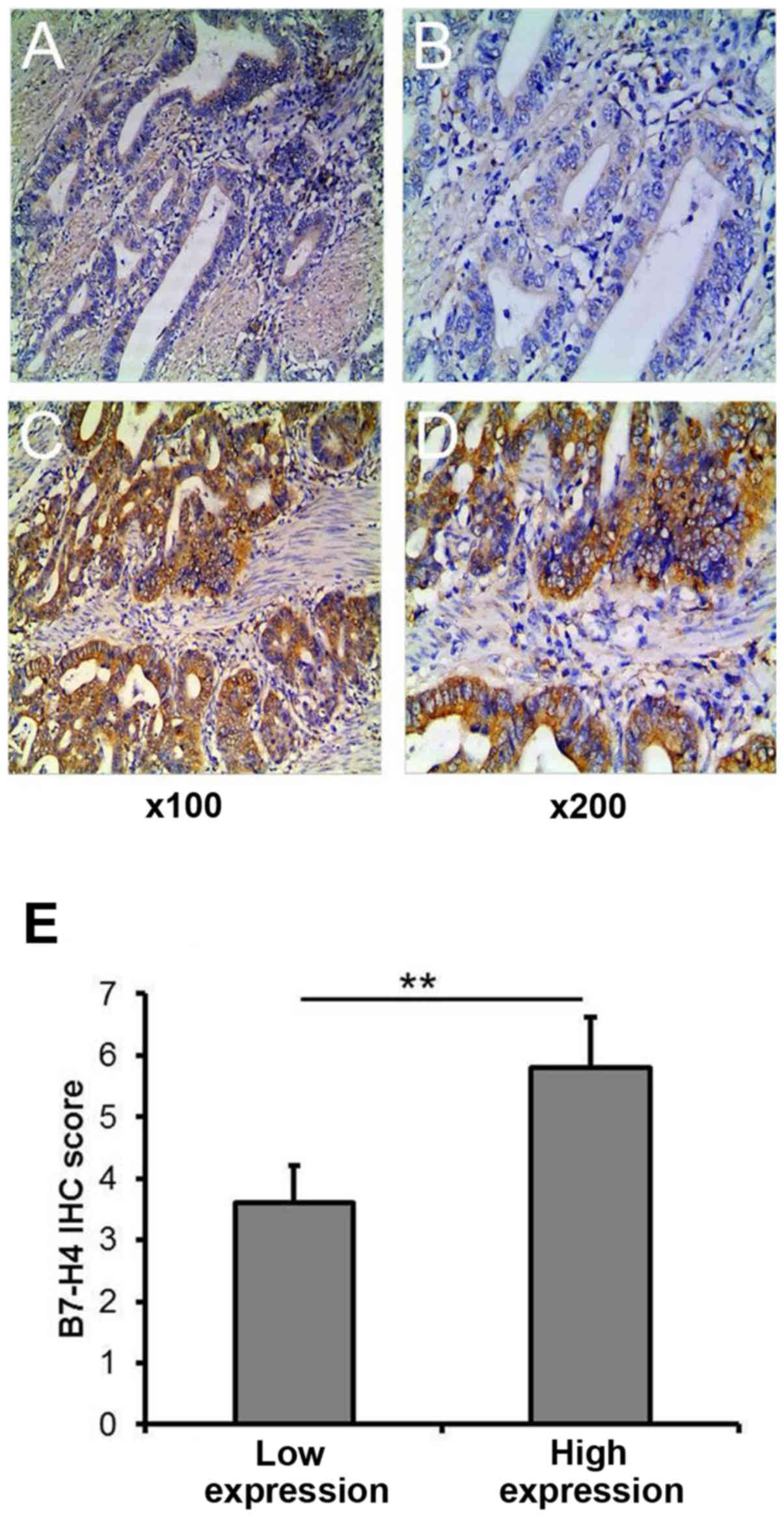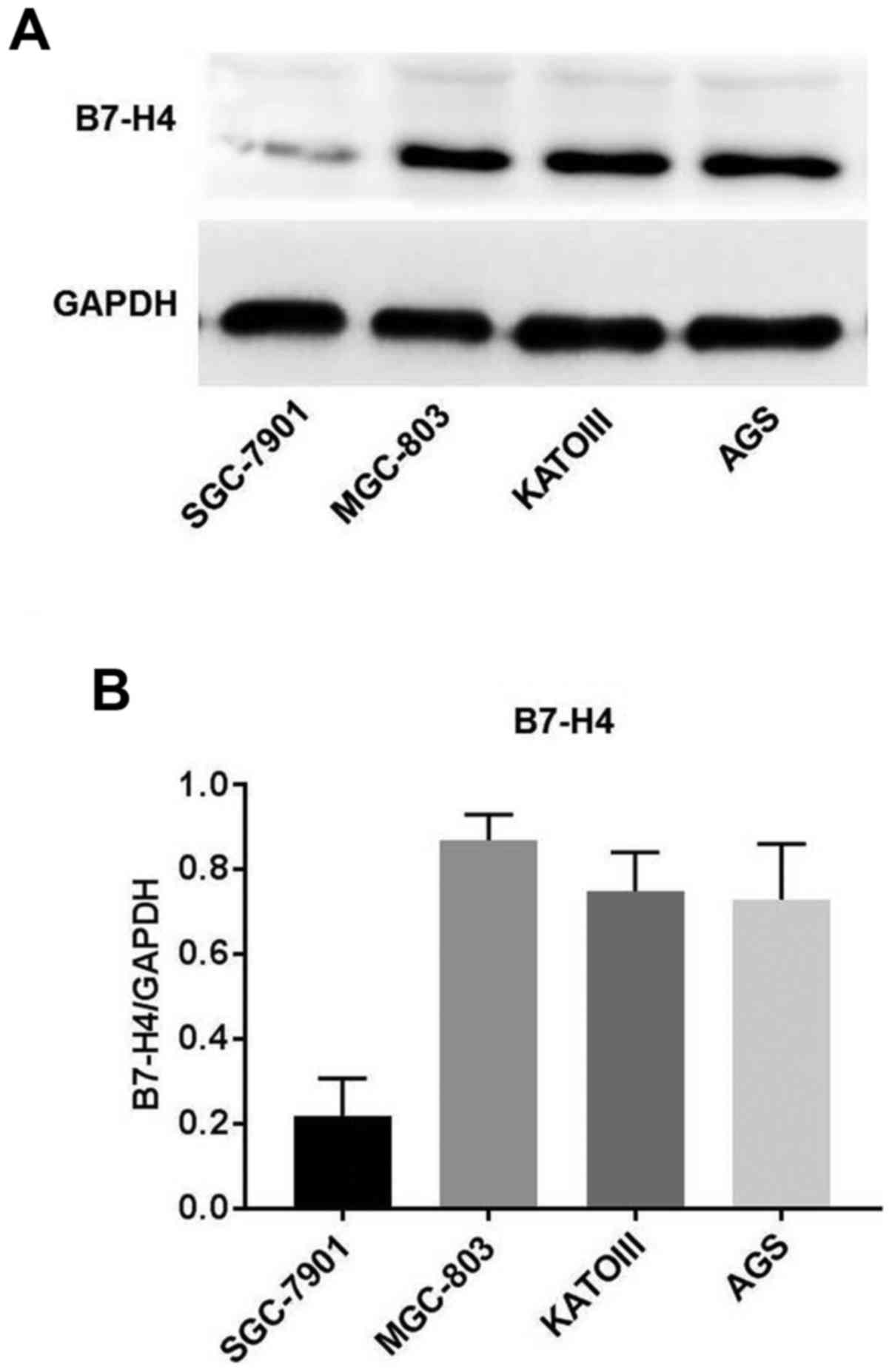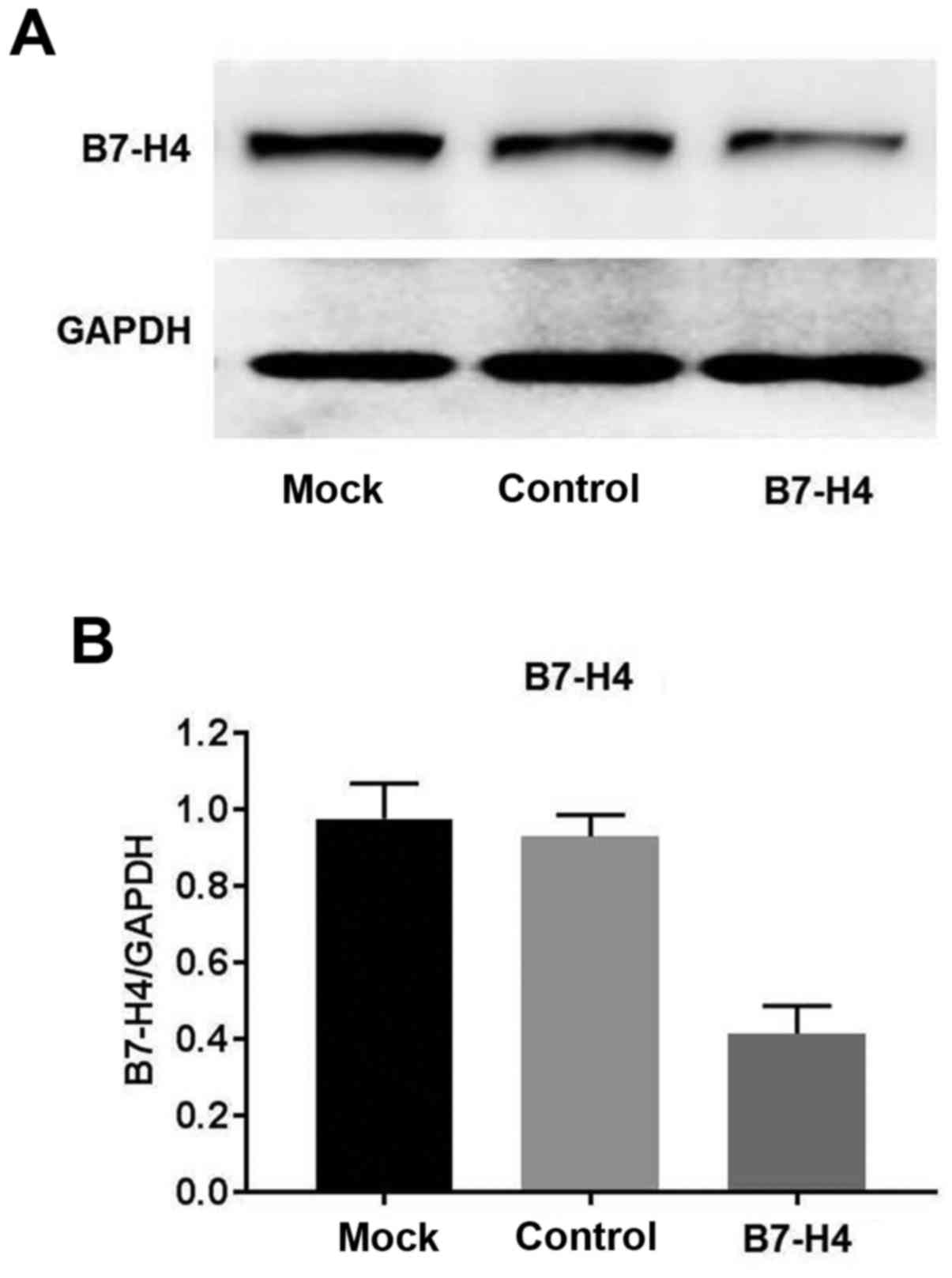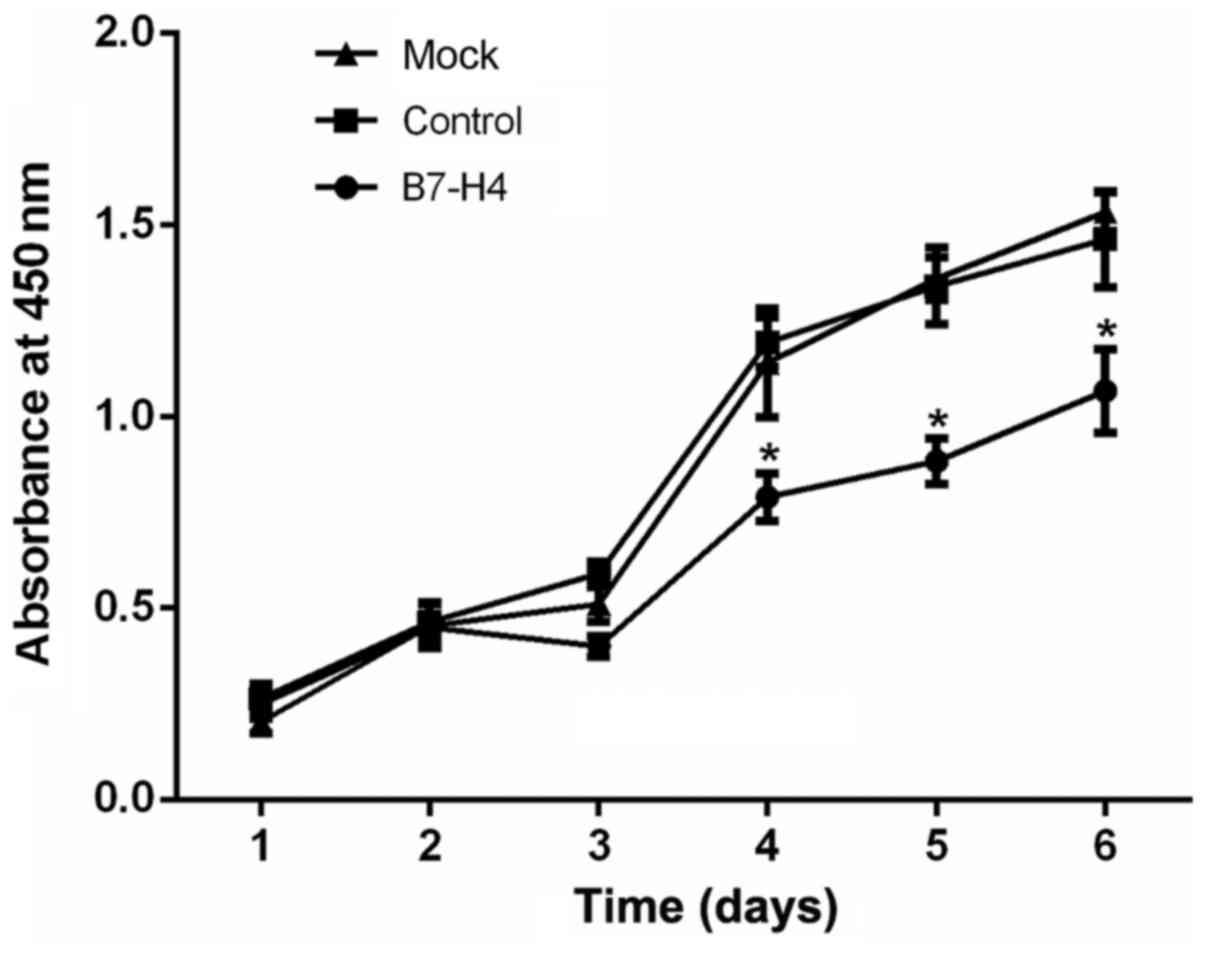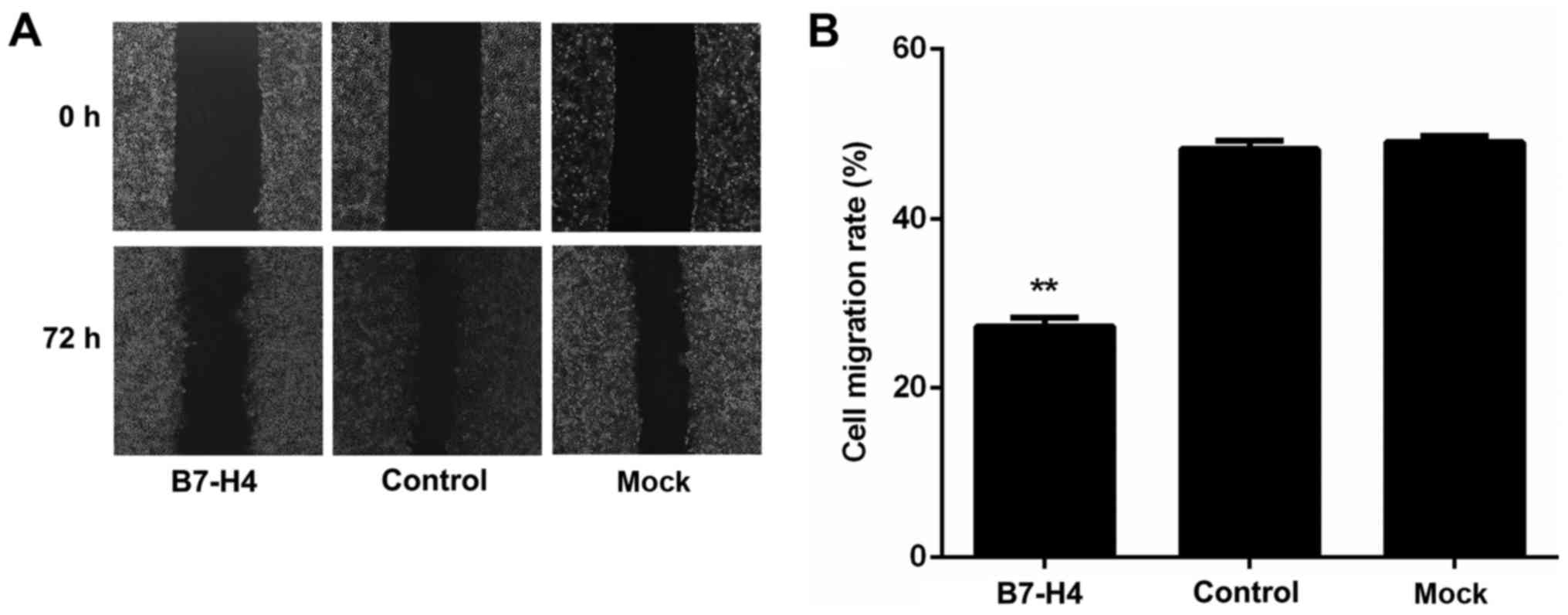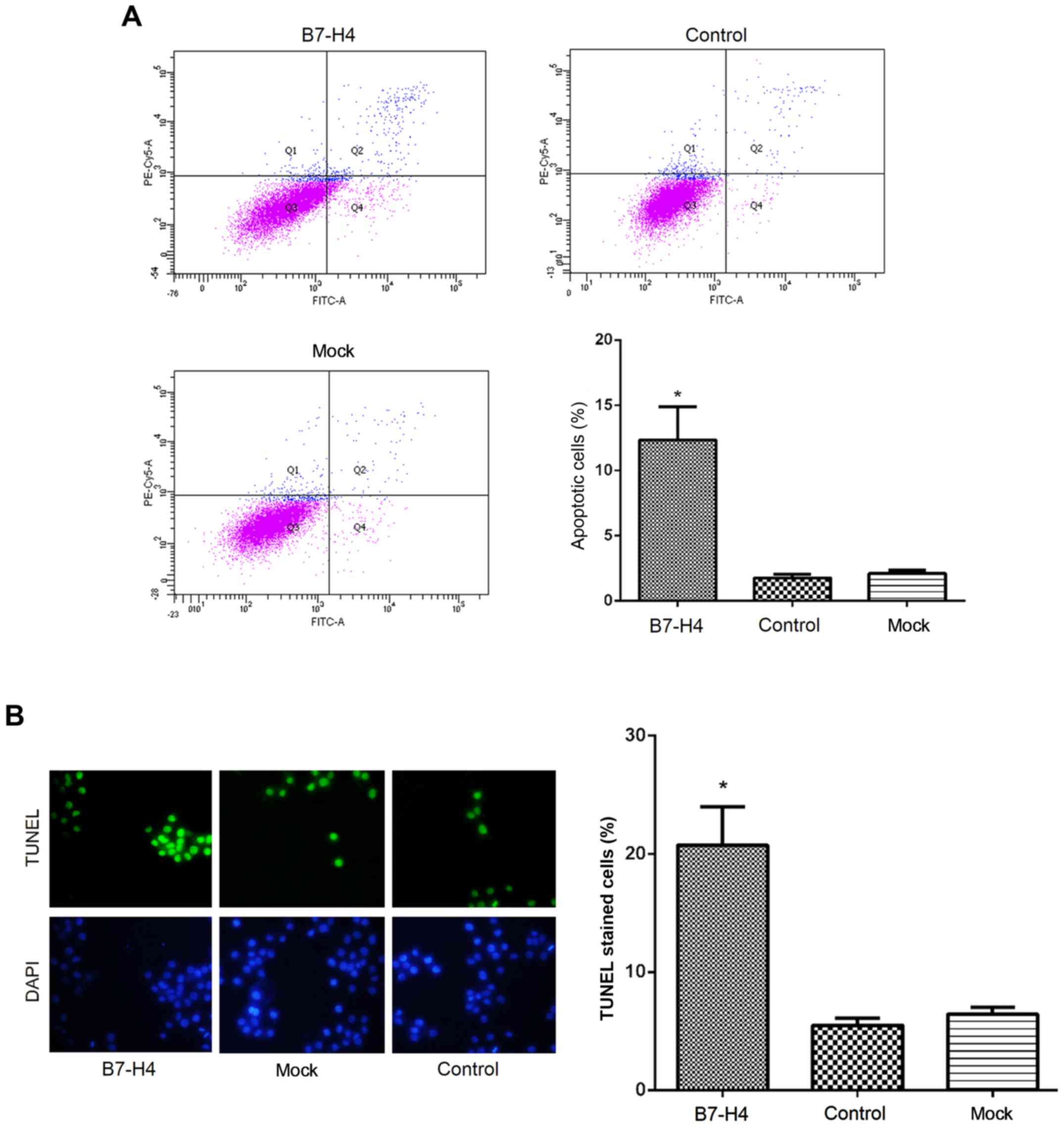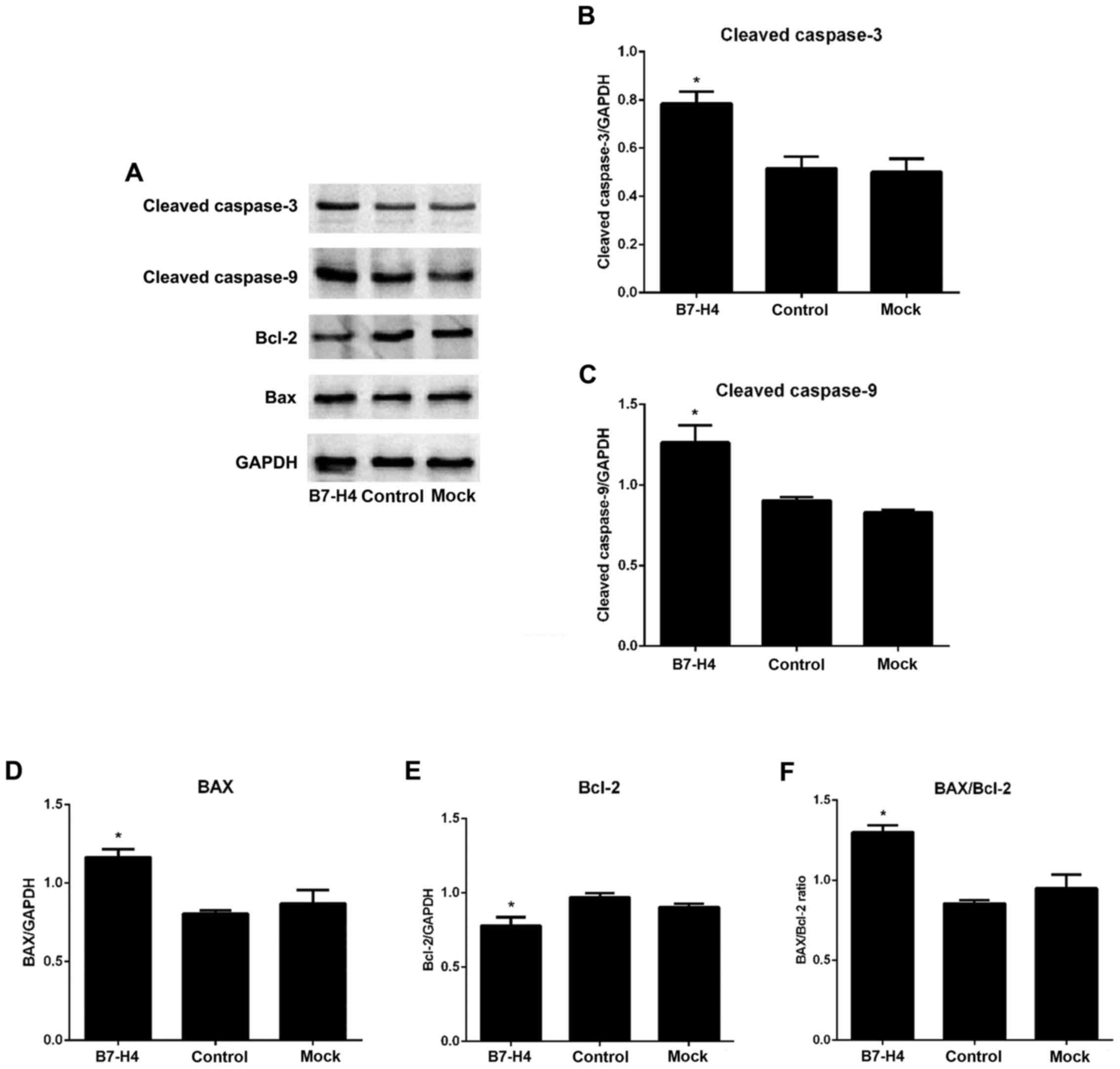Silencing of B7-H4 suppresses the tumorigenicity of the MGC-803 human gastric cancer cell line and promotes cell apoptosis via the mitochondrial signaling pathway
- Authors:
- Published online on: February 13, 2018 https://doi.org/10.3892/ijo.2018.4274
- Pages: 1267-1276
Abstract
Introduction
Although the mortality rate of patients with gastric cancer has declined significantly over the past 10 years, gastric cancer remains a leading cause of cancer-related mortality worldwide (1). In recent years, considerable advances have been made in chemotherapy and personalized treatment, including combined chemotherapy with trastuzumab, a monoclonal antibody against human epidermal growth factor receptor-2 (HER-2), which is now considered as a standard treatment modality for patients with HER-2-positive advanced gastric cancer (2). c-MET inhibitors, such as crizotinib and foretinib, have also received increasing attention (3,4). Despite these developments, the prognosis of patients with advanced gastric cancer remains poor. Therefore, the identification of effective prognostic markers and therapeutic targets is essential to improve the clinical outcomes.
B7-H4, also known as B7x or B7S1, is a member of the B7 superfamily. B7-H4 is a transmembrane protein. A high expression of B7-H4 has been reported in tumor tissues of various types of human cancer, including gastric cancer, ovarian cancer and renal cell carcinoma. Furthermore, B7-H4 is often detected in the tumor microenvironment and peripheral blood (5–9). By contrast, B7-H4 expression is rare in normal human tissues (5,6,10–13). The main roles of B7-H4 in tumor progression are associated with the promotion of tumorigenicity and the regulation of the evasion of tumor cells from immune surveillance. B7-H4 negatively regulates T cell responses in vitro by inhibiting cell proliferation, cell cycle progression and the cytokine production of CD4+ and CD8+ T cells (14–16). In addition, recent studies have demonstrated that blocking B7-H4 with human recombinant specific antibodies may prove to be a novel antitumor therapeutic strategy (17,18).
B7-H4 has been reported to be highly expressed in gastric cancer tissues, and to significantly correlate with tumor invasion, lymph node metastasis, tumor progression and patient outcome (19). In addition, B7-H4 expression in primary gastric tumors has been found to inversely correlate with the number of tumor infiltrating T lymphocytes, suggesting that the activation of the B7-H4 signaling pathway may mediate tumor immune escape (20). However, the pathobiological role of B7-H4 expression and its effects on the tumorigenicity of gastric cancer cells have yet to be fully established. Thus, the aims of this study were the following: i) to evaluate the expression of B7-H4 in gastric cancer tissues and cell lines; ii) to determine the association between its expression and patient clinicopathological characteristics; iii) to examine the effects of the downregulation of B7-H4 on the proliferation, cell cycle progression and the apoptosis of the MGC-803 human gastric cancer cell line; and iv) to investigate the underlying mechanisms of the effects mentioned above on the MGC-803 cells. Aims 'i' and 'ii' listed above were mainly to confirm the status of B7-H4 in gastric cancer tissues and cell lines as in a previous report (8); the aims 'iii' and 'iv' listed above were the novelties of this study and no related reports have been published to date associated with these aims, at least to the best of our knowledge.
Materials and methods
Materials
The human gastric cancer cell lines used in this study were the MGC-803, SGC-7901, AGS and KATOIII cell lines were purchased form ATCC (Manassas, VA, USA). Fetal bovine serum (FBS), Roswell Park Memorial Institute medium (RPMI)-1640 and Dulbecco's modified Eagle's medium (DMEM) were obtained from PAA Laboratories Pty Ltd. (Morningside, QLD, Australia). Oligofectamine reagent was purchased from Invitrogen/Life Technologies (Carlsbad, CA, USA). Small interfering RNA (siRNA) duplexes were constructed by Shanghai GenePharma (Shanghai, China). The Cell Counting kit 8 (CCK-8) was purchased from Dojindo Molecular Technologies (Rockville, MD, USA); the Annexin V/propidium iodide (PI) apoptotic reagent kit was purchased from MultiSciences Biotech (Hangzhou, China); and the In Situ Cell Death Detection kit used for terminal deoxynucleotidyl transferase dUTP nick-end labeling (TUNEL) assays was purchased from Roche (Mannheim, Germany). Antibodies against the following proteins were employed in this study: B7-H4 (Cat. no. ab209242, Abcam, Cambridge, MA, USA). Cleaved caspase-3 (Cat. no. 9661), cleaved caspase-9 (Cat. no. 20750), Bcl-2 (Cat. no. 15071), Bax (Cat. no. 5023) and GAPDH (Cat. no. 5174) were purchased from Cell Signaling Technology (Beverly, MA, USA).
Immunohistochemical (IHC) staining
IHC staining was performed in 311 gastric cancer tissues obtained from tissue microarrays (Chaoying Biotechnology, Shanxi, China), as previously described (21). The slides were semi-quantitatively evaluated by calculating the product of the staining intensity (0–3, least intense to most intense) and the percentage of stained cells (0–4, no cells stained to >75% of cells stained), as previously described (22). The resulting IHC scores were classified into 4 groups as follows: - (negative), 0 points; +, 1–4 points; ++, 5–8 points; and +++, 9–12 points. In this study, a score of <5 was considered as a low expression, and a score of ≥5 was considered as a high expression of B7-H4 protein. All slides were independently scored by two independent clinical pathologists in a blinded manner.
Cell culture and siRNA transfection
The human gastric cancer cell lines, MGC-803, AGS and SGC-7901, were cultured in RPMI-1640 medijm containing 10% FBS, 100 IU/ml penicillin and 100 μg/ml streptomycin. The KATOIII cells were cultured in DMEM containing the same proportions of FBS, penicillin and streptomycin. The cells were grown in a humidified incubator at 37°C and 5% CO2.
The transfection of the MGC-803 cells with siRNA specific for B7-H4 was performed as previously described (23). In brief, B7-H4-specific siRNA (100 nM) and scrambled siRNA (100 nM) duplexes were transfected using oligofectamine reagent according to the manufacturer's instructions. All siRNAs were chemically synthesized by GenePharma (Shanghai, China). The MGC-803 cells that were transfected with B7-H4 siRNA were classified as the B7-H4 group, those transfected with scrambled siRNA were classified as the mock group and untransfected cells were classified as the control group. All experiments were carried out in triplicate (n=3).
Western blot analysis
Cell lysates were prepared using cell lysis buffer according to the manufacturer's instructions (Cell Signaling Technology). Equal quantities of protein from the cell lysates were separated by 12% sodium dodecyl sulfate polyacrylamide gel electrophoresis and transferred onto polyvinylidene difluoride membranes. The membranes were blocked by incubation in 5% non-fat milk for 2 h, and then incubated overnight at 4°C with primary antibodies against B7-H4 (1:10,000), cleaved caspase-3 (1:1,000), cleaved caspase-9 (1:1,000), Bcl-2 (1:1,000), Bax (1:1,000) and GAPDH (1:5,000). The membranes were washed 3 times in phosphate-buffered saline (PBS) and then incubated with anti-rabbit IgG, horseradish peroxidase (HRP)-conjugated secondary antibodies (Cat. no. 7074, Cell Signaling Technology). Immunoreactive proteins were visualized with enhanced chemiluminescence (ECL) reagents (Amersham, Piscataway, NJ, USA) and analyzed using a VersaDoc MP5000 imaging system (Bio-Rad, Hercules, CA, USA). Relative protein expression was quantified using Quantity One 1-D software (Bio-Rad).
CCK-8 proliferation assay
The MGC-803 cells were plated into 96-well plates (5×103 cells/well) and cultured in RPMI-1640 medium containing 2% FBS. At 1–6 days after transfection, the proportions of live cells in the B7-H4, mock and control groups were detected using CCK-8 reagent. Following incubation for 1 h at 37°C, the absorbance (OD) of each group was measured using a microplate reader (iMark, Bio-Rad) at a wavelength of 450 nm. The experiment was carried out in triplicate (n=3).
Cell cycle analysis with PI staining
The procedure for this experiment followed the commonly used method (24). In brief, 2×106 cells were collected and washed with PBS and fixed with −20°C 75% ethanol; the fixed cells were then washed with PBS and treated with 200 μg/ml DNase-free, RNaseA and incubated at 37°C for 30 min; the cells were then washed again and stained with 200 μg/ml propidium iodide (PI) and incubated at room temperature for 5–10 min; the cells were analyzed on a FACSCalibur flow cytometer (BD Biosciences, San Jose, CA, USA). The experiment was carried out in triplicate (n=3).
Wound healing assay
The MGC-803 cells were seeded into 6-well plates (5×105 cells/well) and cultured in RPMI-1640 medium containing 2% FBS. Following transfection with the siRNA for 72 h, scratches were created on the cell cultures using a 200 μl micropipette tip. The cells were photographed (CKX53, Olympus, Tokyo, Japan) at 0 and 72 h after wounding, and the wound areas were measured and compared using Image-Pro Plus version 6.0 software. The experiment was carried out in triplicate (n=3).
Annexin V/PI staining apoptotic assay
The MGC-803 cells were transfected with the siRNA for 72 h and collected using trypsin. They were washed twice with PBS and stained with Annexin V-fluorescein isothiocyanate and PI according to the manufacturer's instructions. The percentages of apoptotic cells were determined by fluorescence activated cell sorting (FACS) using a FACSCalibur flow cytometer (BD Biosciences). The experiment was carried out in triplicate (n=3).
TUNEL assay
The MGC-803 cells were seeded into 12-well plates and transfected with siRNA for 72 h before being fixed with 4% paraformaldehyde in PBS for 1 h. After being washed twice in PBS, the cells were incubated with permeabilization solution (PBS; 0.1% Triton X-100; 0.1% sodium citrate) for 2 min on ice, and then washed in PBS. The cells were incubated with TUNEL reaction mix for 30 min at 37°C, two additional washing steps were performed and the cells were then stained with 4′, 6-diamidino-2-phenylindole (DAPI) for a further 7 min. The number of TUNEL-positive stained cells was divided by the number of DAPI-stained nuclei. A total of 1,000 cells were evaluated at a magnification of ×200 (BX63, Olympus).
Statistical analysis
The association of B7-H4 expression with various clinicopathological parameters was assessed using the Chi-square test and Fisher's exact test. Differences between groups were determined by one-way ANOVA followed by a Dunnet's post hoc test. A P-value <0.05 was considered to indicate a statistically significant difference. All statistical analyses were performed using SPSS version 16.0 software.
Results
Correlation of B7-H4 expression with clinicopathological characteristics in gastric cancer tissues
The protein expression levels of B7-H4 were determined in 311 gastric cancer tissue samples obtained from microarrays by ICH staining. We detected B7-H4 in the membrane and/or cytoplasm of the tumor cells (Fig. 1). High expression levels of B7-H4 (scores of ≥5) were found in 130 (41.8%) cases and low expression levels of B7-H4 (scores of <5) were found in 181 (58.2%) cases. The associations between B7-H4 expression and the clinicopathological characteristics of patients with gastric cancer were determined by examining the clinicopathological information provided by Shaanxi Chaoying Biotechnology. Sample staging was carried out according to 6th edition of the International Union against Cancer (UICC) tumor-node-metastasis (TNM) classification system (25). Our results revealed high levels of B7-H4 expression in a greater number of stage III-IV gastric cancer tissue samples than stage I–II tissue samples (52.3 vs. 34.4%). In addition, B7-H4 expression was found to significantly correlate with lymph node metastasis (P=0.005); however, B7-H4 expression was not significantly associated with patient sex, age, histological grade or the depth of invasion (Table I).
Table ICorrelation of B7-H4 expression with clinicopathological characteristics in human gastric cancer. |
Expression of B7-H4 protein in human gastric cancer cell lines
The protein expression levels of B7-H4 in the human gastric cancer cell lines, MGC-803, SGC-7901, AGS and KATOIII, were examined by western blot analysis. B7-H4 protein was highly expressed in the MGC-803 cells, AGS cells and KATOIII cells, whereas there was little or no expression of B7-H4 protein in the SGC-7901 cells (Fig. 2). B7-H4 expression was found to be the highest in the MGC-803 cells. Therefore, this cell line was selected for use in the subsequent B7-H4 gene silencing experiments.
Expression of B7-H4 is effectively knocked down in MGC-803 cells by siRNA
Western blot analysis confirmed that the expression of B7-H4 was downregulated in the MGC-803 cells following transfection with siRNA specific for B7-H4, compared to the cells transfected with scrambled siRNA (mock) and the untransfected control cells (Fig. 3).
Downregulation of B7-H4 decreases the proliferation of MGC-803 cells
The effects of B7-H4 downregulation on the proliferative ability of the MGC-803 cells were evaluated by CCK-8 assay. The rate of proliferation following at 4 days after transfection was significantly reduced in the B7-H4 group (transfected with B7-H4 siRNA) compared with the mock and control groups (P<0.05; Fig. 4). These data indicated that the downregulation of B7-H4 suppressed the proliferation of the MGC-803 human gastric cancer cells.
Downregulation of B7-H4 induces cell cycle arrest in the MGC-803 cells
The effect of B7-H4 downregulation on the cell cycle of the MGC-803 cells was evaluated by flow cytometric analysis. The percentage of cells in the G1 phase after at 4 days after transfection was significantly elevated in the B7-H4 group (transfected with B7-H4 siRNA) compared to the mock and control groups (P<0.05; Fig. 5). This result demonstrated that the downregulation of B7-H4 induced cell cycle arrest in the MGC-803 human gastric cancer cells.
Downregulation of B7-H4 suppresses the motility of MGC-803 cells
The effect of B7-H4 downregulation on the motility of MGC-803 cells was evaluated by wound healing assay. The results revealed that cell motility was significantly reduced in the B7-H4 group (transfected with B7-H4 siRNA; (27.48±1.06%) compared with the mock group (47.68±1.24%) and the control group (49.55±1.59%); however, there was no significant difference between the mock and control groups (P<0.01, P<0.01 and P>0.05, respectively; Fig. 6). These results demonstrated that the downregulation of B7-H4 suppressed the motility of MGC-803 human gastric cancer cells.
Downregulation of B7-H4 induces the apoptosis of MGC-803 cells
The effect of B7-H4 downregulation on cell apoptosis was evaluated by Annexin V/PI and TUNEL assays. The results of Annexin V/PI assay revealed that the percentage of apoptotic MGC-803 cells was significantly higher (P<0.05; Fig. 7A) in the B7-H4 group (13.45±2.12%) than in the mock group (2.13±1.01%) and control group (1.79±0.54%). This was consistent with the percentage of TUNEL-positive stained cells in the B7-H4 group (21.43±5.78%), which was signifi-cantly increased (P<0.05; Fig. 7B) compared to the mock group (5.34±1.55%) and the control group (6.54±1.25%). These results indicated that the downregulation of B7-H4 induced the apoptosis of MGC-803 human gastric cancer cells.
Downregulation of B7-H4 activates caspase-3 and caspase-9, and alters the Bax/Bcl-2 ratio in the MGC-803 cells
To investigate the effects of B7-H4 downregulation on the apoptotic signaling pathway, we examined the expression levels of cleaved caspase-3, cleaved caspase-9, Bax and Bcl-2 in the MGC-830 cells. The results revealed that the expression levels of the apoptotic markers, cleaved caspase-3 and cleaved caspase-9, were increased in the B7-H4 group compared to the mock and control groups. Similarly, the expression of pro-apoptotic Bax was increased, whereas that of anti-apoptotic Bcl-2 was decreased, thereby altering the Bax/Bcl-2 ratio (P<0.05; Fig. 8). These observations indicated that the down-regulation of B7-H4 activated caspase-3 and caspase-9, and altered the Bax/Bcl-2 ratio in favor of apoptosis. These results also suggested that B7-H4 downregulation may induce the apoptosis of MGC-803 cells via the mitochondrial pathway.
Discussion
Despite the declining incidence and mortality rates of gastric cancer, the 5-year survival rate of patients with stage III–IV gastric cancer is significantly lower than that of patients with stage I–II gastric cancer (26). The expression of B7-H4 has been found to be closely correlated with the tumor stage; furthermore, it has been shown to be a significant independent prognostic factor in gastric cancer (8). Consistent with these reports, in this stuyy, we found that B7-H4 was highly expressed in 41.8% of patients with gastric cancer, and that its expression significantly correlated with lymph node metastasis (P=0.005) and the TNM stage (P=0.002), with a high expression of B7-H4 being detected in 34.4 and 52.3% of stage I–II and stage III–IV tissues, respectively. These results confirmed those of a previous report (8) and proved that our investigation platform was suitable for use in further investigations on gastric cancer materials.
B7-H4 negatively regulates T cell-mediated immune response. Studies have shown that B7-H4 suppresses the generation of allogeneic cytotoxic T cells by inducing cell cycle arrest in vitro (14–16). Conversely, the blockade of endogenous B7-H4 by specific monoclonal antibodies can promote T cell response in vivo (14). In the tumor microenvironment, B7-H4 expression has been detected in tumor-infiltrating macrophages and endothelial cells in small blood vessels (5,6,27). In human ovarian cancer, tumor-associated regulatory T cells have been found to trigger macrophages to produce the interleukin (IL)-6 and IL-10 cytokines, which in turn stimulate B7-H4 expression in antigen-presenting cells in an autocrine/paracrine manner (27). These findings suggest that B7-H4 may contribute to the immune tolerance of tumor cells, thereby promoting tumor progression.
Less is known about the effects of B7-H4 on gastric cancer cell lines and the underlying mechanisms. Therefore, in this study, we examined the expression levels of B7-H4 in human gastric cancer cell lines, and observed the effects of the silencing of B7-H4 by siRNA on the proliferation, motility, cell cycle arrest and the apoptosis of the MGC-803 human gastric cancer cells. We found that B7-H4 was highly expressed in three of the four gastric cancer cell lines examined. B7-H4 gene silencing assays revealed that the downregulation of B7-H4 inhibited the proliferation and motility, and induced cell cycle arrest and the apoptosis of MGC-803 cells, indicating that B7-H4 may play an important role in the tumorigenesis of MGC-803 human gastric cancer cells. A previous study demonstrated that the overexpression of B7-H4 in the SKOV3 human ovarian cancer cell line increased the rate of tumor formation in severe combined immune deficiency mice, whereas B7-H4 knockdown increased caspase activity and the apoptosis of the SKBR3 breast cancer cell line (18). Another study reported that B7-H4 inhibited cell apoptosis and promoted tumor cell growth, adhesion and invasion in an immune-defective model involving SKOV3 cells stably overexpressing B7-H4 (28). B7-H4 has also been shown to play an important immunity-independent role in regulating tumorigenicity in renal cell carcinoma and pancreatic cancer cell lines (23,29). The data of the present study on MGC-803 cells, including the effects of B7-H4 on the cellular and molecular levels and the underlying mechanisms were novel (at least to the best of our knowledge), and had similarities with those of previous reports, which expands our knowledge about the role of B7-H4 in gastric cancer.
Balanced apoptosis is essential to maintain homeostasis and morphogenesis in human tissues, whereas the dysregulation of apoptosis can contribute to tumorigenesis (30). The mitochondrial apoptotic pathway is associated with changes in the permeability of the outer mitochondrial membrane and the collapse of membrane potential. Mitochondrial membrane permeability is mainly controlled by the Bcl-2 family (31,32), which includes pro-apoptotic Bax and anti-apoptotic Bcl-2; consequently, the Bax/Bcl-2 ratio is central to the induction of apoptosis (31). The mitochondrial pathway has also been implicated in the activation of caspase-9, which is an essential initiator caspase required for apoptotic signaling through the mitochondrial pathway and the activation of caspase-3, which is a key executioner of apoptosis (32,33). However, the role of B7-H4 in the mitochondrial apoptotic signaling pathway has not been fully established in gastric cancer. In this study, having confirmed that the downregulation of B7-H4 induced the apoptosis of the MGC-803 cells, we examined its effect on the expression levels of these apoptotic markers. Our results revealed that the knockdown of B7-H4 in MGC-803 cells activated caspase-3 and caspase-9, and altered the Bax/Bcl-2 ratio in a manner that favored apoptosis, thereby demonstrating that the downregulation of B7-H4 induced apoptosis via the mitochondrial signaling pathway.
In conclusion, this study demonstrated the effects of B7-H4 on MGC-803 and clarified the underlying mechanism. Furthermore, this study suggested that B7-H4 may be a valuable prognostic marker and a potential target for individualized therapies in gastric cancer.
However, this study has some limitations. For example, the main data were from only one human gastric cancer cell MGC-803; therefore, conclusions cannot be drawn in general on gastric cancer. Further studies using more human gastric cancer cell lines and even some animal models are warranted, in order to draw more general conclusions related to gastric cancer.
Acknowledgments
Not applicable.
Notes
[1] Funding
This study was supported by a grant from the Zhejiang Provincial Medicine Health Science and Technology Program (2011RCA021).
[2] Availability of data and materials
The analyzed data sets generated during the study are available from the corresponding author on reasonable request.
[3] Authors' contributions
CL and LY performed the oncological analyses, and the analysis and interpretation of the data; YZ and DZ designed the study and drafted the manuscript. All authors have reviewed the final version of the manuscript and approve it for publication.
[4] Ethics approval and consent to participate
Not applicable.
[5] Consent for publication
Not applicable.
[6] Competing interests
The authors declare that they have no competing interests.
[7] Authors' information
Department of Oncology, the First Affiliated Hospital, Zhejiang University School of Medicine, Hangzhou, China (DZ, YZ and CL); Department of Oncology, the Affiliated Dongnan Hospital of Xiamen University, Zhangzhou, China (LY).
References
|
Siegel R, Naishadham D and Jemal A: Cancer statistics, 2013. CA Cancer J Clin. 63:11–30. 2013. View Article : Google Scholar : PubMed/NCBI | |
|
Bang YJ, Van Cutsem E, Feyereislova A, Chung HC, Shen L, Sawaki A, Lordick F, Ohtsu A, Omuro Y, Satoh T, et al ToGA Trial Investigators: Trastuzumab in combination with chemotherapy versus chemotherapy alone for treatment of HER2-positive advanced gastric or gastro-oesophageal junction cancer (ToGA): A phase 3, open-label, randomised controlled trial. Lancet. 376:687–697. 2010. View Article : Google Scholar : PubMed/NCBI | |
|
Lennerz JK, Kwak EL, Ackerman A, Michael M, Fox SB, Bergethon K, Lauwers GY, Christensen JG, Wilner KD, Haber DA, et al: MET amplification identifies a small and aggressive subgroup of esophagogastric adenocarcinoma with evidence of responsiveness to crizotinib. J Clin Oncol. 29:4803–4810. 2011. View Article : Google Scholar : PubMed/NCBI | |
|
Shah MA, Wainberg ZA, Catenacci DV, Hochster HS, Ford J, Kunz P, Lee FC, Kallender H, Cecchi F, Rabe DC, et al: Phase II study evaluating 2 dosing schedules of oral foretinib (GSK1363089), cMET/VEGFR2 inhibitor, in patients with metastatic gastric cancer. PLoS One. 8:e540142013. View Article : Google Scholar : PubMed/NCBI | |
|
Kryczek I, Zou L, Rodriguez P, Zhu G, Wei S, Mottram P, Brumlik M, Cheng P, Curiel T, Myers L, et al: B7-H4 expression identifies a novel suppressive macrophage population in human ovarian carcinoma. J Exp Med. 203:871–881. 2006. View Article : Google Scholar : PubMed/NCBI | |
|
Krambeck AE, Thompson RH, Dong H, Lohse CM, Park ES, Kuntz SM, Leibovich BC, Blute ML, Cheville JC and Kwon ED: B7-H4 expression in renal cell carcinoma and tumor vasculature: Associations with cancer progression and survival. Proc Natl Acad Sci USA. 103:10391–10396. 2006. View Article : Google Scholar : PubMed/NCBI | |
|
Simon I, Zhuo S, Corral L, Diamandis EP, Sarno MJ, Wolfert RL and Kim NW: B7-h4 is a novel membrane-bound protein and a candidate serum and tissue biomarker for ovarian cancer. Cancer Res. 66:1570–1575. 2006. View Article : Google Scholar : PubMed/NCBI | |
|
Arigami T, Uenosono Y, Hirata M, Hagihara T, Yanagita S, Ishigami S and Natsugoe S: Expression of B7-H4 in blood of patients with gastric cancer predicts tumor progression and prognosis. J Surg Oncol. 102:748–752. 2010. View Article : Google Scholar : PubMed/NCBI | |
|
Thompson RH, Zang X, Lohse CM, Leibovich BC, Slovin SF, Reuter VE, Cheville JC, Blute ML, Russo P, Kwon ED, et al: Serum-soluble B7x is elevated in renal cell carcinoma patients and is associated with advanced stage. Cancer Res. 68:6054–6058. 2008. View Article : Google Scholar : PubMed/NCBI | |
|
Sun Y, Wang Y, Zhao J, Gu M, Giscombe R, Lefvert AK and Wang X: B7-H3 and B7-H4 expression in non-small-cell lung cancer. Lung Cancer. 53:143–151. 2006. View Article : Google Scholar : PubMed/NCBI | |
|
Quandt D, Fiedler E, Boettcher D, Marsch WC and Seliger B: B7-h4 expression in human melanoma: Its association with patients' survival and antitumor immune response. Clin Cancer Res. 17:3100–3111. 2011. View Article : Google Scholar : PubMed/NCBI | |
|
Tringler B, Zhuo S, Pilkington G, Torkko KC, Singh M, Lucia MS, Heinz DE, Papkoff J and Shroyer KR: B7-h4 is highly expressed in ductal and lobular breast cancer. Clin Cancer Res. 11:1842–1848. 2005. View Article : Google Scholar : PubMed/NCBI | |
|
Choi IH, Zhu G, Sica GL, Strome SE, Cheville JC, Lau JS, Zhu Y, Flies DB, Tamada K and Chen L: Genomic organization and expression analysis of B7-H4, an immune inhibitory molecule of the B7 family. J Immunol. 171:4650–4654. 2003. View Article : Google Scholar : PubMed/NCBI | |
|
Sica GL, Choi IH, Zhu G, Tamada K, Wang SD, Tamura H, Chapoval AI, Flies DB, Bajorath J and Chen L: B7-H4, a molecule of the B7 family, negatively regulates T cell immunity. Immunity. 18:849–861. 2003. View Article : Google Scholar : PubMed/NCBI | |
|
Prasad DV, Richards S, Mai XM and Dong C: B7S1, a novel B7 family member that negatively regulates T cell activation. Immunity. 18:863–873. 2003. View Article : Google Scholar : PubMed/NCBI | |
|
Zang X, Loke P, Kim J, Murphy K, Waitz R and Allison JP: B7x: a widely expressed B7 family member that inhibits T cell activation. Proc Natl Acad Sci USA. 100:10388–10392. 2003. View Article : Google Scholar : PubMed/NCBI | |
|
Dangaj D, Lanitis E, Zhao A, Joshi S, Cheng Y, Sandaltzopoulos R, Ra HJ, Danet-Desnoyers G, Powell DJ Jr and Scholler N: Novel recombinant human b7-h4 antibodies overcome tumoral immune escape to potentiate T-cell antitumor responses. Cancer Res. 73:4820–4829. 2013. View Article : Google Scholar : PubMed/NCBI | |
|
Salceda S, Tang T, Kmet M, Munteanu A, Ghosh M, Macina R, Liu W, Pilkington G and Papkoff J: The immunomodulatory protein B7-H4 is overexpressed in breast and ovarian cancers and promotes epithelial cell transformation. Exp Cell Res. 306:128–141. 2005. View Article : Google Scholar : PubMed/NCBI | |
|
Jiang J, Zhu Y, Wu C, Shen Y, Wei W, Chen L, Zheng X, Sun J, Lu B and Zhang X: Tumor expression of B7-H4 predicts poor survival of patients suffering from gastric cancer. Cancer Immunol Immunother. 59:1707–1714. 2010. View Article : Google Scholar : PubMed/NCBI | |
|
Arigami T, Uenosono Y, Ishigami S, Hagihara T, Haraguchi N and Natsugoe S: Clinical significance of the B7-H4 coregulatory molecule as a novel prognostic marker in gastric cancer. World J Surg. 35:2051–2057. 2011. View Article : Google Scholar : PubMed/NCBI | |
|
Zhou D, Pan G, Zheng C, Zheng J, Yian L and Teng X: Expression of the RON receptor tyrosine kinase and its association with gastric carcinoma versus normal gastric tissues. BMC Cancer. 8:3532008. View Article : Google Scholar : PubMed/NCBI | |
|
Hao L, Zhang C, Qiu Y, Wang L, Luo Y, Jin M and Zhang Y, Guo TB, Matsushima K and Zhang Y: Recombination of CXCR4, VEGF, and MMP-9 predicting lymph node metastasis in human breast cancer. Cancer Lett. 253:34–42. 2007. View Article : Google Scholar : PubMed/NCBI | |
|
Qian Y, Hong B, Shen L, Wu Z, Yao H and Zhang L: B7-H4 enhances oncogenicity and inhibits apoptosis in pancreatic cancer cells. Cell Tissue Res. 353:139–151. 2013. View Article : Google Scholar : PubMed/NCBI | |
|
Walker PR, Kwast-Welfeld J, Gourdeau H, Leblanc J, Neugebauer W and Sikorska M: Relationship between apoptosis and the cell cycle in lymphocytes: Roles of protein kinase C, tyrosine phosphorylation, and AP1. Exp Cell Res. 207:142–151. 1993. View Article : Google Scholar : PubMed/NCBI | |
|
American Joint Committee on Cancer: AJCC Cancer Staging Manual. 6th edition. Springer-Verlag; New York, NY: 2002 | |
|
Washington K: 7th edition of the AJCC cancer staging manual: Stomach. Ann Surg Oncol. 17:3077–3079. 2010. View Article : Google Scholar : PubMed/NCBI | |
|
Kryczek I, Wei S, Zhu G, Myers L, Mottram P, Cheng P, Chen L, Coukos G and Zou W: Relationship between B7-H4, regulatory T cells, and patient outcome in human ovarian carcinoma. Cancer Res. 67:8900–8905. 2007. View Article : Google Scholar : PubMed/NCBI | |
|
Cheng L, Jiang J, Gao R, Wei S, Nan F, Li S and Kong B: B7-H4 expression promotes tumorigenesis in ovarian cancer. Int J Gynecol Cancer. 19:1481–1486. 2009. View Article : Google Scholar : PubMed/NCBI | |
|
Zhang L, Wu H, Lu D, Li G, Sun C, Song H, Li J, Zhai T, Huang L, Hou C, et al: The costimulatory molecule B7-H4 promote tumor progression and cell proliferation through translocating into nucleus. Oncogene. 32:5347–5358. 2013. View Article : Google Scholar : PubMed/NCBI | |
|
Schultz DR and Harrington WJ Jr: Apoptosis: Programmed cell death at a molecular level. Semin Arthritis Rheum. 32:345–369. 2003. View Article : Google Scholar : PubMed/NCBI | |
|
Korsmeyer SJ, Shutter JR, Veis DJ, Merry DE and Oltvai ZN: Bcl-2/Bax: A rheostat that regulates an anti-oxidant pathway and cell death. Semin Cancer Biol. 4:327–332. 1993.PubMed/NCBI | |
|
Würstle ML, Laussmann MA and Rehm M: The central role of initiator caspase-9 in apoptosis signal transduction and the regulation of its activation and activity on the apoptosome. Exp Cell Res. 318:1213–1220. 2012. View Article : Google Scholar : PubMed/NCBI | |
|
Cohen GM: Caspases: The executioners of apoptosis. Biochem J. 326:1–16. 1997. View Article : Google Scholar : PubMed/NCBI |



